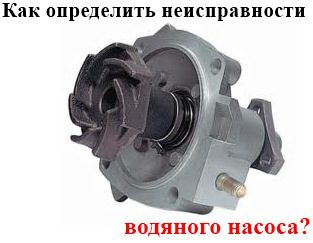
Symptoms of a Faulty or Faulty Water Pump
Content
Common signs include coolant leaks at the front of the vehicle, a loose water pump pulley, engine overheating, and steam coming from the radiator.
To keep your engine cool on hot summer days, your engine must have a constant flow of coolant supplied from the radiator throughout the engine. The water pump is the main component responsible for maintaining this flow. When it works properly, your car will maintain a constant operating temperature, run smoothly, and get you anywhere you need to go. When the water pump fails or begins to wear out, it can lead to complete engine failure.
When the water-cooled engine was introduced (as opposed to the air-cooled engine), many automotive experts believed that the water pump, which circulates coolant through the engine block, was just as important to engine protection as oil. This philosophy remains true even as technology improves over the years to create more efficient cooling systems in today's vehicles. Your vehicle's water pump is the key to the operation of the entire system. This is an impeller pump that is usually hidden under the timing belt cover on the side of the engine. The pump is driven by the motor drive belt - as the belt rotates, the pump rotates. The pump vanes cause the coolant to flow through the engine and back to the radiator for cooling by the forced air cooling fan.
While the water pumps in most modern cars, trucks, and SUVs will last a long time, they are by no means indestructible. Like any other mechanical device, they give out several warning signs of wear, so car owners can contact their local ASE certified mechanic to replace the water pump before additional engine components are damaged.
Here are 5 common symptoms of a bad water pump:
1. Coolant leak at the front of the vehicle.
The water pump consists of multiple gaskets and seals that hold the coolant in and ensure a constant flow of coolant from the radiator to the engine. Eventually, these gaskets and seals wear out, dry out, crack, or break completely. When this happens, the coolant will leak from the water pump and fall to the ground, usually at the front of the vehicle and in the center of the engine. If you notice a coolant leak (which can be green or sometimes red) under the center of your car, truck, or SUV, have a professional mechanic check the problem. More often than not, this is a water pump leak that can be fixed before the situation worsens.
2. Rust, deposits and corrosion of the water pump.
Gradual leakage over time will result in the accumulation of various minerals around the pump. Look under the hood and you may notice rust on the surface of the pump from contaminated or incompatible coolant mixtures or a faulty seal cap that lets in excess air. The wrong coolant will also cause deposits to build up inside the pump, which slows down the ideal engine cooling process. In addition to these signs of wear, you may also notice small corrosion holes in the metal or cavitation - vapor bubbles in the coolant that collapse with enough force to form cavities in the mounting surface. If you notice these symptoms, you should immediately seek a pump replacement.
3. The water pump pulley is loose and making whining noises.
From time to time you may hear a high-pitched sound coming from the front of the engine. This is usually caused by a loose belt that creates a harmonious buzzing or whining sound as it circulates. A loose belt is usually caused by a loose pulley or worn bearings that power the water pump assembly. As soon as the bearings fail inside the water pump, this means that the device cannot be repaired and must be completely replaced.
If you notice a loud whining sound coming from the front of your engine that gets louder as you accelerate, have your vehicle inspected by a mechanic as soon as possible.
4. Engine overheats
When the water pump fails completely, it will not be able to circulate coolant through the cylinder block. This causes overheating and, if not repaired or replaced promptly, can lead to additional engine damage such as cracked cylinder heads, blown head gaskets, or burnt pistons. If you notice that the engine temperature sensor gets hot frequently, it is most likely a water pump problem. You should contact a mechanic to check the problem and replace the water pump if necessary.
5. Steam coming out of the radiator
Finally, if you notice steam coming out of the front of your engine when you are driving or stopping, this is an instant sign of engine overheating. As discussed above, the engine will maintain a constant temperature when the water pump is working properly and delivering water to a functioning radiator. If you notice steam coming from the front of your engine, you should stop in a safe place and contact a mechanic as soon as possible. It's never a good idea to drive with an overheated engine, so if you have to call a tow truck to get your car home, it can save you significant money in the short and long term - it'll be cheaper than a complete engine replacement. .
Any time you notice any of these warning signs, contact your local ASE certified mechanic so they can repair or replace the water pump and get your vehicle back on the roads without delay.
